Canine Coat Colour Genetics & The Miniature Schnauzer
Learn Your Colour Alphabet
A number of books have been written over the years on canine genetics, the most referenced being that of Clarence Little, published in 1957. Many of Little's theories have been proven correct, some not. It is important when considering the inheritance of coat colour in dogs to double check your sources - it is only in very recent years that research in molecular genetics has begun to identify the genes responsible for colour and explain the chemical processes behind them.
As previously mentioned, the colours we see in canines, wild and domestic are the result of interactions of many gene pairs located at several loci. Some breeds have many alleles, or gene variations, available in their gene pool, some have very few.
(I will indicate which of these genes have been identified, the rest of the information presented here is based upon published theory and personal observation.)
A is for Agouti.
The Agouti series has been mapped to chromosome 24. A pigment switch/patterning series, it does not produce pigment, but controls where and when eumelanin (black) and pheomelanin (tan) based pigment is deposited in the coat. There are several alleles considered to be part of this series. Mouse studies indicate that dominant mutations produce more tan or "yellow" in the coat, while recessive mutations along the series produce more black.
The pattern we call salt and pepper may be a distinct allele or a variation of "wild colour". Whatever the case may be, the pattern seems only to exist in wire dachshunds (called wild boar) and the schnauzers.
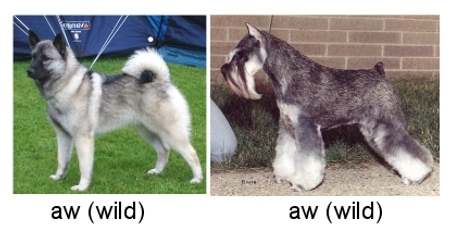
|
The series, in order of dominance;
Ay (yellow) > aw (wild) ?> ap (pepper) > at (tanpoint) > a (solid black)
|
(Saddle tan, as seen in German Shepherds and Airedales, may be a form of tanpoint, or a separate allele of its own.) The alleles for Ay yellow and recessive black have been identified, and tests for these genes exist. (Recessive black should not be confused with the more common dominant black, and is thought to occur only in a few herding breeds). Research is ongoing into the other alleles in this series. |
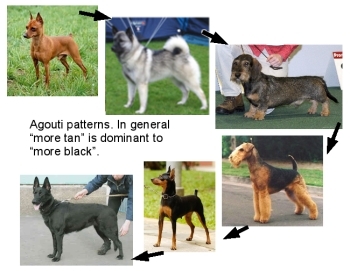
|
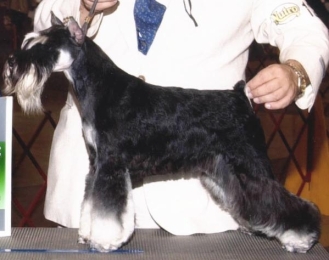
|
Black & silvers are genetic "atat" (tanpoint). Agouti pepper and tanpoint are the only two alleles on the agouti series found in the Mini Schnauzer gene pool. Thus, all schnauzers are "apap", "apat", or "atat" at the agouti locus. |
Some of the alleles in this series tend not to be completely dominant.

apap
apat
atat
B is for Brown.
|
B Series - Brown dilution has been mapped to chromosome 11. (There are actually three variations of brown, and all produce brown when matched with each other.) B (normal black) > b (brown) This allele alters the structure of black pigment, and converts it to brown. The dominant B of this series is best thought of "normal for black", while b - "brown" is recessive. When a dog inherits two copies of brown dilution all black pigment is affected, including nose leather and pads. It's a common allele in purebred dogs, and responsible for liver spaniels, chocolate labs and red Dobermans to name just two of many. |
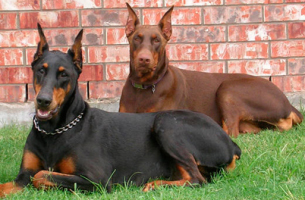
|
Miniature schnauzers are homozgyous "BB" at this locus
Brown was not originally considered a Miniature Schnauzer colour and is not mentioned in the standard. The late breed historian, Anne Eskrigge specifically mentions the absence of brown in her writings. However, anyone who has access to the internet has the opportunity to see "liver" or "chocolate" schnauzers of all patterns.
C is for Chinchilla
C - chincilla series thought to dilute pigment of all types. Known in mice, cattle humans but recent studies have found no genes in this series that affect canine coat colour. Produces albinism. It's included here only to update those who have seen it mentioned in earlier writings.
D is for Dilution
|
D - dilution causes dilution of both black and tan pigment, but changes to black are more noticable . Present at birth, "dd" dilution affects nose and skin. This gene has been mapped to chromosome 25, though mutations may vary from breed to breed. Thus, the DNA tests that are available are breed specific. Dilution is sometimes associated with hair loss. The "blue" and "isabella" Dobermans are examples of "dd" dilution acting upon black and brown and acts upon nose and eye colour as well. D (normal pigment) > d (diluted) Miniature schnauzers are "DD" at this locus Dilution is not known to occur in Miniature Schnauzers, but if there is doubt, a check of nose colour will clearly distinguish a blue from a faded black. |
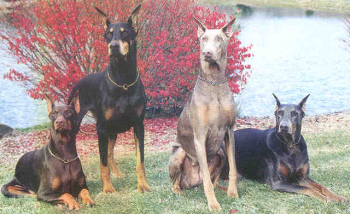 |
E is for Extension
E - extension series. This series has been mapped to chromosome 5. There are three known alleles -
|
"Em" facial masking is the type found in the Great Dane, Mastiffs, Pugs and the Leonberger pictured. It is a different facial pattern than that which creates the black overlay of hair that drapes from the bridge of the nose on Miniature Schnauzers. A Mini Schnauzer with Em masking should lack tan points on his face, and if present in the breed, must be very rare. |
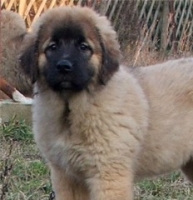 |
"E" allows for the normal production of black pigment throughout the body.
"e" is a recessive mutation that produces a non-functional receptor and results in the inability for the hair follicle to produce black pigment. (Because the agouti genes interact with the hormone (MSH) that produces black pigment, ee dogs are unaffected by genes on the agouti series. Thus, "ee" dogs do not show tan points or banded hairs, regardless of what the genes on the agouti series code for.)
It's important to understand that this allele can result in tan shades that range from rich red (Irish Setter) to golden (yellow lab) to pure white (white poodle). Indeed, poodles are a breed in which the range of tan expression is quite wide - from white to red.
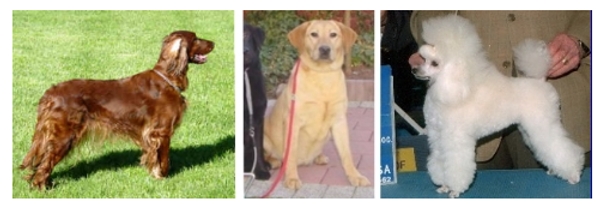
|
"e" is the allele responsible for the white Miniature Schnauzer. This has been confirmed through genetic testing by two separate labs, and a commercial test is available for those wishing to keep this recessive out of their lines. |
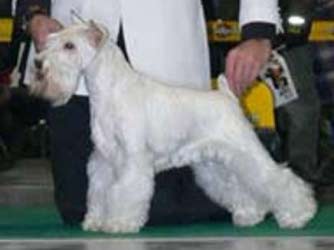
"ee" schnauzer |
G is for Greying
G - progressive Greying. Greying is dominant over g, non-greying. Greying affects both pigment types, and is an effect produced by the slowed production of tyrosine of the hair follicle, which is required for the production of melanin. The gene has been mapped in horses, where it is associated with higher rates of skin melanoma.
G (greying) > g (non-greying) Greying is present in a large number of breeds, and responsible for the lightening of Kerry Blue terriers as they age. The greying allele is almost certainly present in Miniature Schnauzers, and explains the lightening of overlays on salt&peppers, and fading of unstripped areas of blacks and black/silvers. Note: When the hair follicle is stimulated through stripping, normal production of pigment is restored. The phenomenon also occurs when the skin of a greying dog is traumatized through surgery, vaccination or injury - the hair that regrows regains colour intensity and the area shows up as a spot in the grey. |  |
I is for Intense
I - intense, a new locus proposed that dilutes only phaeomelanin (tan), and leaves black unaffected. Soft Coated Wheaten Terriers are genetic "ayay" sables with this type of dilution. Thought responsible for the silvering of tan points and banding in Miniature Schnauzers. Dominant, with all schnauzers being homozygous "ii".
I (normal intensity) > i (dilute)
The difference between the red points and colour bands of the "wild boar" dachshund and the silvered points and bands of schnauzers are due to the effects of this allele.
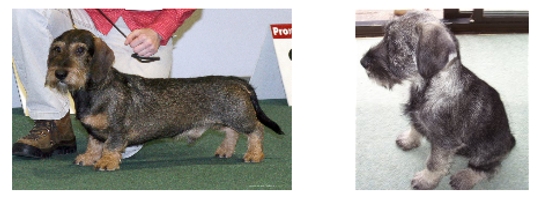
An accidental cross between an "ii" Miniature Schnauzer with an "II" (deep red ears) Jack Russell terrier in my kennel a few years ago produced a puppy with light tan body coat, which suggests that this gene has intermediate expression in heterozygotes.
K is for blacK
|
K - dominant black, has been mapped to chromosome 16 in dogs. It's the most common form of black in dog breeds. (Recessive black, on the agouti series, seems confined mostly to a few herding breeds). This gene plays an important role in immunity in several species, and has never before been shown to affect pigmentation. A genetic test now exists to distinguish Kk dogs from KK homozygous blacks. Brindle is also on this series. K (black) > kbr (brindle) > k (permits yellow) "K" is the allele responsible for black miniature schnauzers. Salt & pepper or black/silver schnauzers are by necessity, "kk" at this locus. |
 |
M is for Merle
|
M - Merle has been mapped to chromosome 10. A dominant (or co-dominant) gene that creates alternating patterns of dark and light pigment. Also called "dapple" in dachshunds. M (merle) > m (normal) Merle is a semi-lethal gene, and MM homozygotes are mostly white in colour, usually deaf and sometimes blind. |
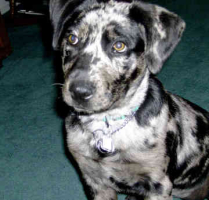
|
Not part of the legitimate schnauzer gene pool, thus all schnauzers are "mm" at this locus.
S is for Spotting
Best thought of as "lack of pigment", with affected areas having white hair.
Extreme white Spotting in boxers and bull terriers has been mapped to chromosome 20. This gene causes a failure of melanocytes to migrate during fetal development, resulting in unpigmented areas of skin and hair.
The extreme white spotting gene is codominant with solid in these breeds, with heterozygotes exhibiting "flashy" white markings. Homozyotes are "extreme whites" with high risk of deafness.

Piebald "sp" is another type of spotting that is recessive to solid, mapped to chromosome 20. It results in the random spots and patches of varying size. This is the form of particolour spotting seen in fox terriers, beagles, papillons, whippets, and increasing numbers of miniature shnauzers being registered with the AKC .
There may be several alleles on this series, with "more colour" generally dominant to "less colour".
Schnauzers in the legitimate gene pool should be "SS" at this locus.
Research into spotting genes is ongoing, and commercial tests already exist for some breeds.
This puppy is from a cross of a solid salt/pepper miniature schnauzer sire and a smooth haired Jack Russell terrier bitch who was all white save for her ears, which were both a deep red (ay sable). Note also that the intensity of red pigment has been diluted, the result of receiving one gene for tan dilution at the I (intense) locus.
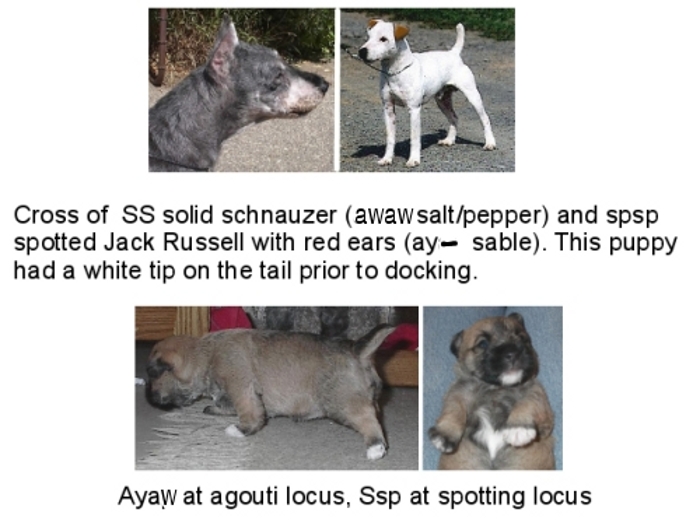
| Irish spotting - this distinctive pattern of white color, feet and undersides (as seen in basenjis, collies) May be part of the spotting series mentioned above. If so, it's recessive to solid and dominant to "sp" piebald spotting. | 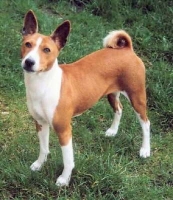 |
| White chest spots and toe tips - because melanocytes migrate from the spinal column downwards during fetal development, any delay of the process may result in small white areas on the chest, toes or underbelly. Such delays could be due to nutrition, position in the womb, etc. These small patches of white are not considered to be an inherited spotting trait, though the rate of melanocyte migration may be. | 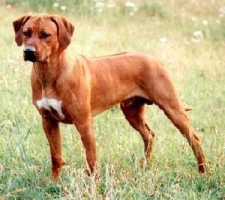 |
T is for Ticking
|
T (ticking) > t (non-ticked) T - ticking, also called roan, is the presence of small white pigmented spots on white areas. Dominant, but not visible in "S-" solid dogs. Ticking can consist of a few scattered flecks or be quite heavily distributed - the variation suggests to some that there may be multiple alleles in the gene series. | 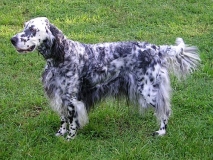
|
Dalmatians are "extreme white" particolour dogs (with the associated risk of deafness) that may have a form of ticking.
Next...